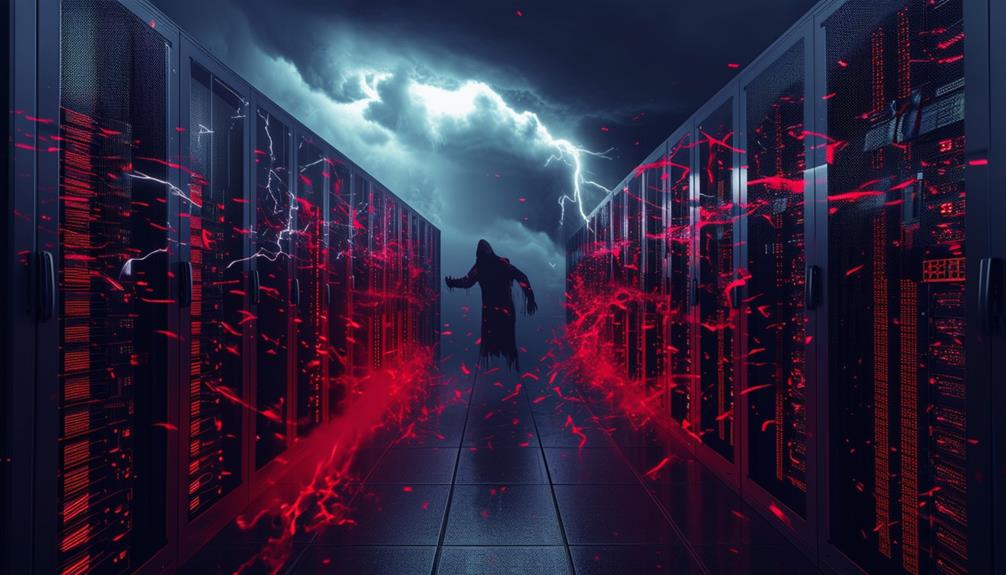Cloud computing offers incredible advantages, but it's also a hotbed for emerging cybersecurity threats.
As businesses increasingly migrate their operations online, cybercriminals are honing their tactics to exploit vulnerabilities in this new environment.
Sophisticated ransomware is now targeting cloud-native systems, while AI-driven attacks are designed to outsmart conventional security measures.
These developments signal a shift in the cybersecurity landscape, making it essential to stay informed.
Understanding these evolving threats is key to safeguarding your digital assets.
Let's explore the pressing risks in cloud computing and what they mean for your organization.
Key Takeaways
- Cloud-native ransomware attacks target centralized data, exploiting misconfigurations and weak access controls in complex cloud infrastructures.
- AI-powered cyber threats enhance attack sophistication, using adaptive malware and convincing phishing tactics to evade detection.
- Supply chain vulnerabilities in cloud ecosystems create multiple entry points for attackers through compromised vendor systems.
- Serverless computing introduces unique security challenges due to distributed functions and relinquished infrastructure control.
- Quantum computing poses risks to current cryptographic systems, potentially compromising sensitive data stored in cloud environments.
Cloud-Native Ransomware Attacks

Three critical factors have led to the rise of cloud-native ransomware attacks. First, the widespread adoption of cloud services has created a larger attack surface for cybercriminals. Second, the centralization of data in cloud environments makes them attractive targets for high-value payoffs. Third, the complexity of cloud infrastructures often leads to misconfigurations that attackers can exploit.
Cloud-native ransomware attacks differ from traditional ones by targeting cloud-specific vulnerabilities. These attacks often exploit misconfigured access controls, unpatched vulnerabilities in cloud services, or weak authentication mechanisms. They can quickly spread across interconnected cloud resources, encrypting vast amounts of data and disrupting business operations.
To protect yourself from cloud-native ransomware, you'll need to implement robust security measures. Regularly audit your cloud configurations, enforce strong access controls, and use multi-factor authentication. Keep your cloud services and applications up-to-date with the latest security patches.
Implement data encryption both in transit and at rest. Develop and test a thorough incident response plan that addresses cloud-specific scenarios. Finally, maintain regular backups of your cloud data, storing them in a separate, secure location to guarantee quick recovery in case of an attack.
AI-Powered Cyber Threats

Artificial Intelligence (AI) is revolutionizing cybersecurity threats in cloud computing. You'll face increasingly sophisticated attacks as cybercriminals leverage AI to automate and enhance their tactics.
AI-powered malware can adapt to your security measures, making it harder to detect and neutralize. These threats can learn from your cloud environment, finding vulnerabilities and exploiting them faster than human hackers.
You'll encounter AI-driven phishing attacks that craft highly convincing emails and messages, tailored to individual users based on their online behavior and social media profiles. These attacks are more likely to bypass traditional filters and trick even security-savvy employees.
AI can also be used to generate deepfakes, creating realistic audio or video content to manipulate your staff or customers.
Moreover, you'll need to watch out for AI-powered botnets that can coordinate massive DDoS attacks on your cloud infrastructure, overwhelming your defenses. These intelligent botnets can dynamically adjust their attack patterns, making them more resilient to mitigation efforts.
As AI technology advances, you'll face an arms race between AI-powered attacks and AI-enhanced defense systems, requiring constant vigilance and investment in cutting-edge security solutions.
Supply Chain Vulnerabilities

While AI-powered threats pose significant risks, they're not the only concern in cloud security. Supply chain vulnerabilities have emerged as a critical issue in cloud computing.
You need to be aware that your cloud infrastructure relies on a complex network of vendors, service providers, and third-party software. Each link in this chain presents a potential entry point for cybercriminals.
Attackers can exploit weaknesses in your suppliers' systems to gain access to your cloud environment. They might compromise software updates, insert malicious code into third-party applications, or exploit vulnerabilities in hardware components.
You're particularly at risk if you've integrated services from multiple providers without thoroughly vetting their security practices.
To protect yourself, you must implement robust vendor management processes. Conduct regular security assessments of your suppliers, enforce strict access controls, and monitor third-party activities within your cloud ecosystem.
Additionally, consider implementing a zero-trust architecture to minimize the impact of a potential breach. By treating every component of your supply chain as a potential threat, you'll be better equipped to detect and mitigate risks before they escalate into full-blown security incidents.
Serverless Security Challenges

Serverless computing frequently introduces unique security challenges that you need to address. As you shift to this model, you're relinquishing control over the underlying infrastructure, making it harder to implement traditional security measures.
You'll face increased attack surfaces due to the distributed nature of serverless functions, which can be triggered by various events. Function isolation becomes essential, as poorly configured permissions may allow unauthorized access between functions.
You'll need to implement robust authentication and authorization mechanisms for each function. Data security is another concern, as serverless architectures often involve frequent data transfers between functions and external services.
Monitoring and logging become more complex in serverless environments. You'll need to adapt your security tools to handle the ephemeral nature of serverless functions.
Dependency vulnerabilities are also a significant risk, as serverless applications often rely on numerous external libraries and services. To mitigate these risks, you should implement least privilege access, use API gateways for centralized security controls, encrypt data in transit and at rest, and regularly update and scan your dependencies.
Additionally, consider using serverless-specific security tools and best practices to enhance your overall security posture.
Quantum Computing Risks

Quantum computing poses a significant threat to current cryptographic systems, potentially undermining the security foundations of cloud computing. As quantum computers become more powerful, they'll be able to break many of the encryption algorithms used today, including RSA and ECC. This puts your sensitive data stored in the cloud at risk of exposure.
You'll need to prepare for the post-quantum era by implementing quantum-resistant cryptography. These new algorithms are designed to withstand attacks from both classical and quantum computers. However, shifting to quantum-safe encryption isn't a simple task. It requires careful planning and execution to avoid disrupting your existing cloud infrastructure.
Another risk is the potential for quantum computers to simulate complex systems, which could be used to find vulnerabilities in cloud architectures. Attackers might exploit these weaknesses to gain unauthorized access or disrupt services.
To mitigate this threat, you'll need to invest in quantum-safe security measures and regularly assess your cloud environment for potential vulnerabilities.
As quantum computing advances, you must stay informed about the latest developments and adapt your cloud security strategies accordingly. This includes working closely with cloud providers to guarantee they're implementing quantum-resistant solutions.
Conclusion
You're facing a rapidly evolving landscape of cloud security threats. From ransomware targeting centralized data to AI-powered attacks and supply chain vulnerabilities, the risks are diverse and complex. Don't forget the unique challenges of serverless computing and the looming threat of quantum computing. To stay ahead, you'll need to implement thorough security measures, including regular audits, robust access controls, and quantum-resistant encryption. Stay vigilant and adaptable to protect your cloud assets.

